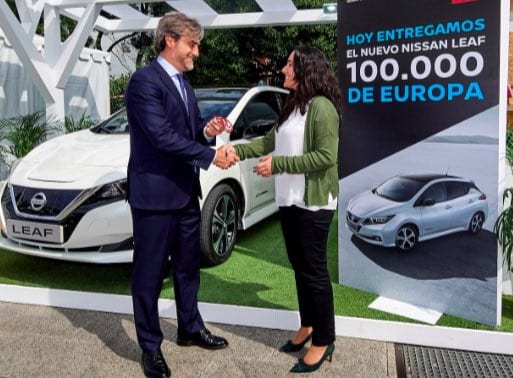Japanese car giant Nissan has announced a major new milestone for its LEAF electric vehicle, with 100,000 of the first and second generation EVs now sold in Europe, taking its global total to 320,000.
The figure includes 37,000 of the new generation LEAFs sold in the last eight months – or one car sold ever 10 minutes across Europe – and has helped elevate the car to the top spot in EV sales across the world.
The milestone buyer of the 100,000th LEAF was Susana de Mena, of Madrid (pictured above).
“We are very conscious that we must respect and protect the environment, so we knew we’d want to go 100 per cent electric,” she said in a company statement.
“On top of this, an electric car lets us get to the very centre of Madrid when ordinary vehicles can sometimes be restricted due to pollution issues.”
Madrid, like other cities in Europe, is favouring electric cars over petrol and diesel vehicles, and(Bloomberg reports that the Madrid city council allows free parking for electric cars, for example).
“For us it’s no surprise that the Nissan LEAF is the world’s best-selling electric vehicle,” Gareth Dunsmore, EV director of Nissan Europe, said in a statement.
“We have been developing our electric vehicle mass-market offering for longer than any other brand and are proud to bring an affordable, visionary car to customers across Europe.
“In less than 10 years, we managed to make electric vehicle a mass market reality. This milestone proves once again that our Nissan Intelligent Mobility vision is embraced by our customers who believe in a more confident, more exciting, and more connected future.”
Australians will have to wait longer for the next generation of the Nissan LEAF, now expected in early 2019.
European countries such as Norway and France have introduced various fiscal incentives to help overcome the still high purchase price of EVs, including trade-ins in France, but the uptake is still strong in countries where EV support policies were not available.
Nissan says LEAF sales throughout Europe have equated to a saving of over 300,000 tonnes of CO2, basing the number on over 2 billion kilometres of driving to date.











